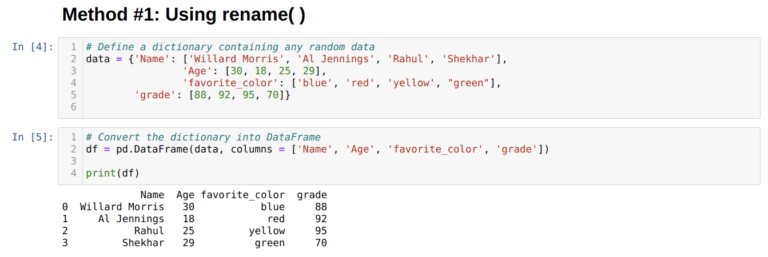
In this article we discussed four methods for renaming the column in pandas DataFrame with examples. Here we renamed id column with student_id, name column with student_name, age column with student_age, subjects column with Programming and displayed the column names Summary You can use the following functions from the dplyr package in R to rename multiple columns in a data frame. Student_id student_name student_age Programming *** Rename all Column names in Dataframe one by one ***** Print('*** Rename all Column names in Dataframe one by one *****')ĭata.columns = ('id', 'student_id')ĭata.columns = ('name', 'student_name')ĭata.columns = ('age', 'student_age')ĭata.columns = ('subjects', 'Programming')
RENAME DATAFRAME COLUMNS HOW TO
How to compare two columns in a pandas DataFrame?.Pandas: Add two columns into a new column in Dataframe.Pandas : Check if a value exists in a DataFrame using in & not in operator | isin().➠ Rename all columns of a dataframe (Suffix): Python list comprehension is used along with "col" function to rename all the columns of a dataframe by adding a suffix value, you can visit this page to learn more about List comprehension.ĭf_suffix = df. This is particularly helpful in avoiding name conflicts after joining 2 dataframes having common column names.ĭf_prefix = df.select() ➠ Rename all columns of a dataframe (Prefix): Python list comprehension is used along with "col" function to rename all the columns of a dataframe by adding a prefix value, you can visit this page to learn more about List comprehension.

Example 1: Column db_type was renamed to db_type_cd in the below example using column functions col and alias inside select function.įrom import col,lit,substringĭf_updated = df.select("db_id", "db_name", col("db_type").alias("db_type_cd"))Ĭolumn_li.insert(idx,col(existing_col_name).alias(new_col_name)).➠ Rename Column using select: select function can also be used to rename existing column, only downside is that user has specify all the dataframe columns(list can be accessed using df.columns) in select i.e columns which are required in final output. Example 2: Column db_type_test is not present in the given dataframe, therefore dataframe was returned as it is in the below example.ĭf_updated = df.withColumnRenamed("db_type_test","db_type_cd").Example 1: Column db_type was renamed to db_type_cd in the below example.ĭf_updated = df.withColumnRenamed("db_type","db_type_cd").This function takes 2 string parameters, 1st parameter is the name of the existing column and 2nd parameter is the new name of the column. Using DataFrame. If you wanted to remove from the existing DataFrame, you should use inplaceTrue. Note that by default it returns the copy of the DataFrame after removing rows. WithColumnRenamed(existingColumnName, newColumnName) By using () method you can filter rows with Nan (Not a Number) and None values from DataFrame. If the dataframe schema does not contain the given column then it will not fail and will return the same dataframe. ➠ Rename Column using withColumnRenamed: withColumnRenamed() function can be used on a dataframe to rename existing column.

➠ List all Columns: columns attribute can be used on a dataframe to return all the column names as a list.


ĭf = ("file:///path_to_files/csv_file_with_duplicates.csv", header=True) Sample Data: Dataset used in the below examples can be downloaded from here.


 0 kommentar(er)
0 kommentar(er)
